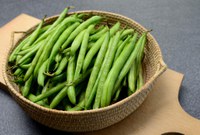Prairie Fare: Use modern processes when canning
(Click an image below to view a high-resolution image that can be downloaded)
By Julie Garden-Robinson, food and nutrition specialist
NDSU Extension
Sometimes when I do food preservation training, people talk about using their great-grandparents’ “time-tested canning recipes.” Some of the recipes are still safe but others make the hair on the back of my neck stand on end.
I believe our hard-working ancestors would want us to follow the innovations that came with time and research. Most of us do not routinely drive Model T’s of our grandparent’s era on the highway these days.
Why would we use 100-year-old technology unless we are driving a classic car in a parade?
I’d like to tell you a story about Elmer. He escaped illness and death by avoiding vegetables 91 years ago.
Elmer’s story was a tragic one for his friends.
Back in 1931, many people attended a gathering in rural North Dakota. The guests were served a salad sprinkled with home-canned peas. Elmer did not have any salad because he did not like vegetables.
Eventually, 13 people died due to a then little-understood illness known as botulism. Three of the party hosts’ children survived because they were too young to attend the party. They stayed in their rooms.
Unfortunately, another four people died in a similar situation in a rural area in western North Dakota the same year. They ate green beans improperly canned at home. When they fed the leftover beans to 40 chickens, the chickens died too.
Canning equipment, such as pressure canners, and research-based directions were scarce in those days. If you are reading this, your ancestors probably followed the common rule of thoroughly boiling all home-canned food for at least 10 minutes after removing it from the jar.
Although the botulism toxin can be inactivated by boiling home-canned food before serving it, that’s not a good recipe for safe preservation or nutrition. It takes a tiny amount of the toxin to make you seriously ill, and the longer you boil food, the more nutrition you can lose.
If you follow the U.S. Department of Agriculture procedures precisely, you do not need to boil home-canned food before serving it.
Botulism is an illness associated with the microorganism, Clostridium botulinum, commonly found in the soil. Consuming the toxin can paralyze the nervous system and lead to suffocation. Symptoms appear within 12 to 36 hours of consuming the food.
The first signs of botulism are flu-like, including nausea, vomiting and dizziness. Later signs include blurred or double vision, difficulty swallowing, fatigue and difficulty breathing. Botulism can be fatal unless an antitoxin is administered.
The botulism toxin can form in oxygen-free environments such as in jars of low-acid foods (including vegetables and meat) canned improperly in a pressure canner. A pressure canner allows temperatures to reach 240 degrees Fahrenheit, which can inactivate the botulinum spores inside the jar.
Until World War II, research on home food preservation was scant. Food rationing was in effect in the early 1940s, and “Victory Gardens” and home food preservation helped ensure food security for U.S. households.
Home canning rose to 4.1 billion jars canned at home and in community canning centers in 1943 according to the U.S. Department of Agriculture National Agricultural Library.
Pressure canners were rationed, too, which resulted in sharing of canning equipment.
If you are growing your own modern-day Victory Garden, be sure to follow current procedures, which are available free online from your local Extension office in any state and from the National Center for Home Food Preservation.
When you preserve food, you are a scientist. Follow these tips to ensure safety.
- Follow current, research-tested recipes and canning procedures. Use a pressure canner for vegetables, meats and most mixtures of food. A pressure canner should hold at least four quart-sized jars.
- Use new canning lids and do not reuse old ones. Lids should be washed but not boiled as our grandmothers might have done. Lid technology has changed. However, if you use special “reusable” lids, follow the manufacturers’ guidance.
- You can reuse Mason-style jars and the screw bands repeatedly unless they are damaged. Remove the screw bands before storing the jars in a cool, dark place.
- Add lemon juice or citric acid in the specified amounts to all tomatoes before canning.
- Use 5% acetic acid vinegar in pickling recipes.
- Use two-piece lids on jams and jellies, not paraffin wax. Jams and jellies should be processed in a boiling water-bath canner to inactivate molds and yeasts.
- Do not alter research-tested salsa recipes by adding extra peppers or onions. Follow the formulation and add the lemon juice or vinegar the recipe recommends.
- See ag.ndsu.edu/food and visit the food preservation section. It has safe recipes for canning, freezing, pickling, fermenting, drying and more. See www.ag.ndsu.edu/fieldtofork for information about growing and preparing vegetables.
Here’s one of my favorite recipes to can. Pickled green beans do not have to be pressure-canned because of the added vinegar.
Pickled Dilled Beans
4 pounds fresh tender green or yellow beans (5 to 6 inches long)
8 to 16 heads fresh dill
8 cloves garlic (optional)
½ cup canning or pickling salt
4 cups white vinegar (5% acidity)
4 cups water
1 teaspoon hot red pepper flakes (optional)
Wash and trim the ends from the beans and cut to 4-inch lengths. In each sterile pint jar, place one to two dill heads and, if desired, one clove of garlic. Place whole beans upright in jars, leaving ½ inch of head space. Trim the beans to ensure proper fit, if necessary. Combine the salt, vinegar, water and pepper flakes (if desired). Bring to a boil. Add the hot solution to the beans, leaving ½ inch of head space. Adjust the lids and process in a boiling water-bath canner for five minutes at altitudes of 0 to 1,000 feet or 10 minutes at 1,001 to 6,000 feet. Makes about eight pints of pickled beans.
(Julie Garden-Robinson, Ph.D., R.D., L.R.D., is a North Dakota State University Extension food and nutrition specialist and professor in the Department of Health, Nutrition and Exercise Sciences. Follow her on Twitter @jgardenrobinson)
NDSU Agriculture Communication – July 14, 2022
Source: Julie Garden-Robinson, 701-231-7187, julie.garden-robinson@ndsu.edu
Editor: Elizabeth Cronin, 701-231-5391, elizabeth.cronin@ndsu.edu




